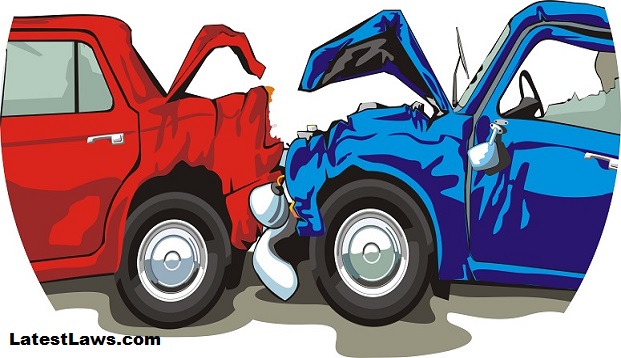August 11,2018:
The Author, Meenakshi Jain, she has recently completed her LLM from Dept. of Law, Punjabi University, Patiala, Punjab. She is currently interning with LatestLaws.com.
Q1. What are Motor Accident Claims Tribunal?
According to Sec. 165 of Motor Vehicle Act, 1988 MACT deals with claims relating to compensation in respect of accident involving the death of, or bodily injury to, person arising out of the use of motor vehicles or damages to any property of a third party so arising or both.Q2. Jurisdiction and Presided Officer of MACT?
MACT courts are presided over by judicial officer from Delhi Higher Judicial Service. Now these are under direct supervision of Hon’ble High Court of various states. Tribunals take away the jurisdiction of Civil Courts for all purposes of Sec. 195 and Ch XXVI of CPC, 1973 in the matters which concerns the MACT.
Q3. What is Accident Report and it’s Contents?
Accident investigation report form 54 of the Central Motor Vehicle Rules, 1989 is a form filled by management in case of accident. It contains specific information which helps in investigation and for claim in Claims Tribunal. Such as: Name of Victim, Date, Time and Location of Accident, Statement of Witness, Injuries occurred and Action Taken.
Q4. What are the Key-Points of Jai Prakash’s Case?
Jai Prakash v/s National Insurance Co. (2010 ACJ 455) deals with problems relating to accident claims in accident cases, delay in adjudication, compensation given to family members, SC give direction to Police Authorities and Claims Tribunal to deal with accident cases.
Following Directions were given by Supreme Court to Police in relation to Detailed Accident Report Procedure:
(a) Accident Information Report in Form 54 of the Central Motor Vehicles Rules, 1989 ( the AIR for short) shall be submitted by the police ( Station House Officer) to the jurisdictional Motor Accidents Claims Tribunal within 30 days of the registration of the F.I.R. In addition to the particulars required to be furnished in Form 54, the police should also collect and furnish the following additional particulars in the AIR to the Tribunal : (i) The age of the victim at the time of accident ; (ii) The income of the victim; (iii) The names and ages of the dependent family members.
(b) The AIR shall be accompanied by the attested copies of the F.I.R., site sketch/mahazar/photographs of the place of occurrence, driving licence of the driver, insurance policy ( and if necessary, fitness certificate) of the vehicle and post-mortem report ( in case of death) or the injury/wound certificate ( in the case of injury). The names/addresses of injured or dependent family members of the deceased should also be furnished to the Tribunal.
(c) Simultaneously, copy of the AIR with annexures thereto shall be furnished to the concerned insurance company to enable the insurer to process the claim.
(d) The police shall notify the first date of hearing fixed by the Tribunal to the victim (injured) or the family of the victim (in case of death) and the driver, owner and insurer. If so directed by the Tribunal, the police may secure their presence on the first date of hearing.
Q5. Which Section of MVA deals with Accident Application and Nature of Application?
Report of accident receives under sec. 158(6) as application for compensation U/S. 166(4) of Act. Tribunal should institutes a register for recording AIRs and register these as Miscellaneous Petition.
Q6. What enquiries MACT can make?
Tribunal ensures that AIR should be real and not fabricated, Can classify the claims, Follow the procedure of summary inquiry and fix the amount of compensation and ascertain the number of dependents of victim.
Q7. Who is Amicus Curiae?
A member of Bar who inform the Court when doubtful or mistaken of any fact or decided cases with his usual thoroughness and submitted a report and suggestions for consideration.
Q8. What documents to be attached with AIR?
Copy of FIR, Copy of MLC/ Post Mortem Report/ Death Report, Doc. Of Identity of Claimant, Original Bill of expenses and treatment Record, Cover note of third party insurance policy etc.
Q9. Time limit foe submission of AIR and Appeal?
S.H.O of concerned Police station should submit the within 30 days of submission of FIR with a copy of Insurance Co. Appeal should be made within 90 days to higher authority such as High Court.
Q10. What are the duties of Insurance Co.?
Where liability of insurance co. is not disputed the insurer should pay the amount to deceased family without waiting for MACT decision or settlement in Lok Adalat. Otherwise Insurer directed to deposit the amount within 30 days of determination.
Q11. What are the aims of MACT?
SC directed MACT to provide victims seedy justice, ensure justice to all victims, all dependants of deceased get compensation and quantum of compensation, run schemes for better implementation of these laws.
Q12. Types of Awards given by MACT?
Sec. 171: Award of Interest: MACT fix simple interest on rate as it thinks fit along with award of compensation.
Sec. 172: Award of Compensatory Cost: where mi-representation of case, vexatious claim or defence is done.
Picture Source :


























